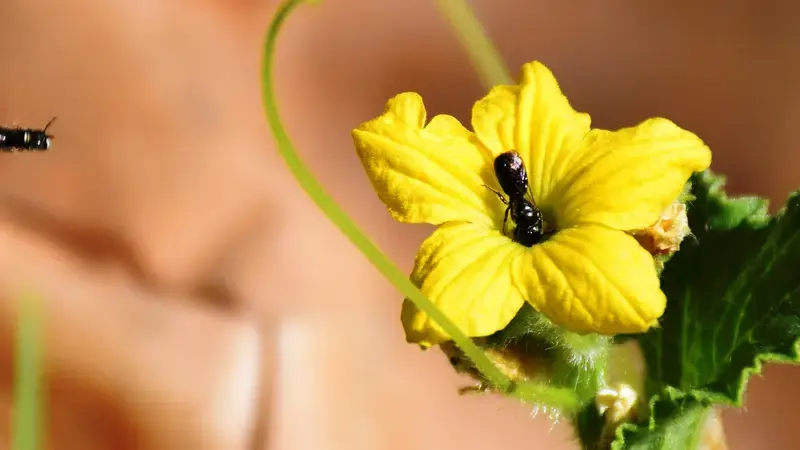Farming with Alternative Pollinators (FAP)

- Stefanie Christmann – Lead Scientist, ICARDA’s FAP Senior Scientist, and Team Leader
ICARDA uses the first economically self-sustaining and climate-smart approach to protect pollinators and raise farmers' incomes: Farming with Alternative Pollinators (FAP).
Three-quarters of the most important global food crops and 87 percent of all flowering plants depend on pollinators, making it vital to protect wild pollinators and sustain their environmental benefits, especially in countries or regions that do not have or cannot afford agroecological schemes. Pollinators are basic for biodiversity on its three levels: genetic diversity, diversity of plants, and of habitats, and they are indispensable for terrestrial ecosystems and human wellbeing.
It is wild pollinators and not honeybees, that provide the majority of pollination services. Without their contribution, vital food plants and crops cannot be pollinated, and many plants would become extinct. Soil biodiversity would then erode, and soil fertility would be reduced, in turn leading to food insecurity, out-rural mass migration, high unemployment, and civil instability.
The most common way to attract pollinators is to pay or subsidize farmers to plant ‘reward-based wildflower strips on the edges of fields, and high-income countries like the European Union spend billions of euros on such schemes. However, farmers dislike or simply reject wildflowers that they see as a type of weed that takes up valuable acreage. Paying compensation to farmers for such schemes is also too costly for low- and middle-income countries.
FAP allows farmers to raise the diversity and abundance of natural pollinators and natural enemies (animals that reduce crop pests), while still getting income from farmers’ entire land. It does this by allotting about 25% of a field to a pollinator habitat enhancement zone in which – instead of wildflowers - only marketable habitat enhancement plants (MHEP) are grown. MHEP such as oilseeds, spices, vegetables, or medicinal plants is perfect for pollinator habitat enhancement. The 25% zone also hosts nesting support out of local or waste materials such as hollow stems, packed bare soil, and old wood with boreholes.
If the farmer’s main crop is pollinator-dependent, the raised abundance and diversity of wild pollinators through FAP enhance its yield productivity and often its quality, while the natural enemies substantially reduce pest abundance. The result is that farmers earn more per surface and invest less in chemicals.
The FAP team has tested FAP in different countries and settings to demonstrate agronomic replicability, and it has been shown to clearly intensify production through the improved contribution of two vital ecosystem services: pollination and pest control. The incentive is not paid by an external donor as in the EU but is based on higher income per surface, which ensures scalability in low- and middle-income countries, as well as sustainability because farmers want to have a high income.
However, the incentive is also performance-related. Farmers will benefit more than others if they are able to see wild pollinators and natural enemies as beneficial, recognizing the importance of nests or nesting material while protecting the sites from deep tillage or tillage at a critical time, and other habitat destructive factors such as chemical use. Therefore, the FAP innovation package includes capacity-building components for agricultural advisors and farmers through videos, brochures, on-site training, and ICT. This also covers important information about the MHEP such as which works well at which season and in which agroecological systems.
Demonstrating the economic value of pollinators through FAP is key to convincing farmers to protect them. FAP includes cross-sector policies which support governments in low- and middle-income countries to protect pollinators in a cost-effective way. Curricula change and mass-media components help to raise knowledge in the entire population as pollinators need to be protected e.g. also in urban areas, while FAP-introduction components enable pollinator protection in agricultural land, and promotion of pollinator-related ecotourism supports pollinator protection in common landscapes and urban areas.
-------------------------------------------------------------------------------------
IMPACT
-
Morocco, the benchmark country of the IKI project “Conservation of Pollinator Diversity for Enhanced Climate Change Resilience” joined the Coalition of the Willing on Pollinators in May 2019.
-
FAP has substantially increased agricultural production per surface often by 100% or more where it is deployed.
-
FAP significantly reduces pest abundance, often by 50% and more.
-
The water productivity of pollinator-dependent crops is often higher than of most pollinator-independent crops like rice or wheat in particular in relation to the income per crop Vs cost of invested water (for example apricot Vs wheat). This makes pollinators particularly valuable for dry regions.
-
In an era of an alarming decline in pollinators, FAP helps to protect 87% of all flowering plants which hold a vital source of climate-smart crops adaption (biodiversity), produce food and medicine, important raw materials (cotton, linen, rapeseeds, sunflower, biofuels), improve soil fertility, sequester Co2, help purify water and create the landscapes we call our homes.

Further Reading:
Stefanie Christmann, Aden A. Aw-Hassan, Yasemin Güler, Hasan Sarisu, Marc Bernard, Moulay Chrif Smaili, Athanasios Tsivelikas. (28/4/2021). Two enabling factors for farmer-driven pollinator protection in low- and middle-income countries. International Journal of Agricultural Sustainability. https://repo.mel.cgiar.org/handle/20.500.11766/13052
Stefanie Christmann. (9/12/2019). Climate change enforces to look beyond the plant – the example of pollinators. pp. 1-6.
https://repo.mel.cgiar.org/handle/20.500.11766/10982
Stefanie Christmann. (1/1/2019). Under which conditions would a wide support be likely for a Multilateral Environmental Agreement for pollinator protection. Environmental Science and Policy, 91, pp. 1-5. https://repo.mel.cgiar.org/handle/20.500.11766/8496
